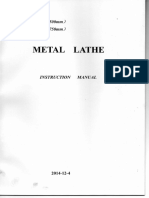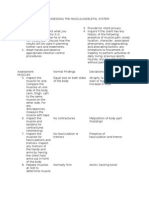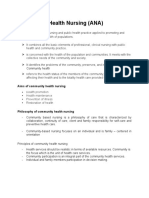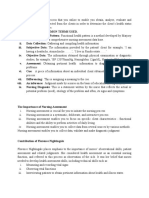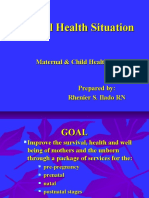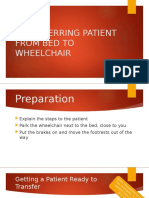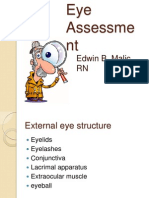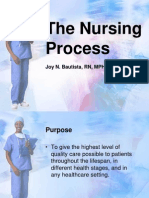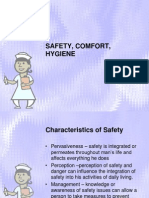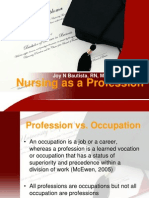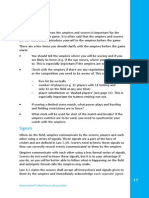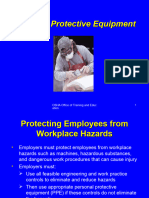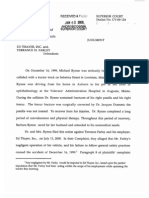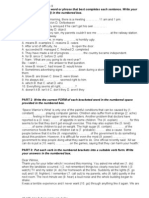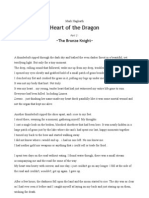06 EENT Assessment
06 EENT Assessment
Uploaded by
HerlinaNababanCopyright:
Available Formats
06 EENT Assessment
06 EENT Assessment
Uploaded by
HerlinaNababanOriginal Description:
Copyright
Available Formats
Share this document
Did you find this document useful?
Is this content inappropriate?
Copyright:
Available Formats
06 EENT Assessment
06 EENT Assessment
Uploaded by
HerlinaNababanCopyright:
Available Formats
Joy N.
Bautista, RN, MPH, DRDM, MAN
EENT assessment
Health History: EYES
Corrective lenses for distance or for reading? Blurred vision, blind spots, floaters, double vision, discharge, or unusual sensitivity to light? Trouble seeing at night? Eye injury or eye surgery? Lazy eye? Allergies? Last eye examination? Complaints of eye pain or headaches? Squint to see objects at a distance? Hold objects close to his eyes to see them?
Health History: GENERAL EYE HEALTH
Family History
hypertension, diabetes, stroke, multiple sclerosis, syphilis, or HIV glaucoma, cataracts, vision loss, or retinitis. Digoxin overdose can cause a patient to see yellow halos around bright light Exposure to chemicals, fumes, flying debris, or infectious agents Wear eye protection Smoking increases the risk of vascular disease, which can lead to blindness and can damage vision.
Medication History Occupation
Smoking
Health History: PEDIATRIC EYE
Delivered vaginally or by cesarean birth? If delivered vaginally, mother have a vaginal infection at the time? (Inform the parents that infection such as chlamydia, gonorrhea, genital herpes, or candidiasis can cause eye problems in infant.) Erythromycin ointment instilled in his eyes at birth? Passed the normal developmental milestones? Know how to hold and care for sharp objects such as scissors?
Health History: ELDERLY EYE
Any difficulty climbing stairs or driving? Tested for glaucoma? When? Result? If with glaucoma, eye drops? What kind? How well can Px instill eye drops? Eyes feel dry? Burn? How treated?
Physical Exam: EYE TOOLS
a good light source a penlight one or two opaque cards an ophthalmoscope (DOCTORS NEED THIS!) vision-test cards gloves tissues cotton-tipped applicators
Physical Exam: GENERAL APPEARANCE
Observe the patients face. With the scalp line as the starting point check that his eyes are in normal position.
They should be about one-third of the way down the face and about one eyes width apart from each other.
Then assess the eyelid, conjunctiva, cornea, anterior chamber, iris, and pupil.
Physical Exam: EYELIDS
Upper eyelid cover top quarter of the iris so the eyes look alike. Check for an excessive amount of visible sclera above the limbus (corneo-scleral junction). Ask the patient to open and close his eyes to see of they close completely. If the downward movement of the upper eyelid in down gaze is delayed, the patient has a condition known as lid lag, which is a common sign of hyperthyroidism. Assess the lids for redness, edema, inflammation, or lesions. Check for a stye, or hordeolum, a common eyelid lesion.
Physical Exam: EYELIDS
Inspect the eyes for excessive tearing or dryness. The eyelid margins should be pink, and the eyelashes should turn outward. Observe whether the lower eyelids turn inward toward the eyeball, called entropion, or outward, called ectropion. Examine the eyelids for lumps. Note tenderness, swelling of the nasolacrimal duct or discharge through the lacrimal point, which could indicate blockage of the nasolacrimal duct.
Physical Exam: CONJUNCTIVA
Bulbar conjunctiva should be clear and shiny (Px looks up). Note excessive redness or exudate. Inspect the bulbar conjunctiva for color changes, foreign bodies, and edema. Observe the scleras color, which should be white to buff. Palpebral conjunctiva should be uniformly pink (Px looks down). Cobblestone appearance in Pxs with allergies.
Physical Exam: CORNEA
The cornea should be clear and without lesions. Test corneal sensitivity by lightly touching the cornea with a wisp of cotton.
The patient should blink. If he doesnt blink, he may have suffered damage to the sensory fibers of cranial nerve V to the motor fibers controlled by cranial nerve VI. Keep in mind that people who wear contact lenses may have reduced sensitivity because theyre accustomed to having foreign objects in their eyes.
Physical Exam: ANTERIOR CHAMBER & IRIS
The iris should appear flat, and the cornea should appear convex. Excess pressure on the eye such as that caused by acute angle-closure glaucoma may push the iris forward, making the anterior chamber appear very small. The irises should be the same size, color, and shape.
Physical Exam: PUPIL
Each pupil should be equal size, round, and about one-fourth the size of the iris in normal room light. Test the pupils for accommodation
Place your finger approximately 4 inches (10.2 cm) from the bridge of the patients nose. Ask the patient to look at a fixed object in the distance and then to look at your finger. His pupils should constrict and his eyes converge as he focuses on you finger.
Physical Exam: PUPILS
Test the pupil for direct and consensual response.
In a slightly darkened room, hold a penlight about 20 (50.8 cm) from the patients eyes Direct the light at the eye from the side Note the reaction of the pupil youre testing (direct response) and the opposite pupil (consensual response). They should both react the same way. Note sluggishness or inequality in the response. Repeat the test with other pupil.
Physical Exam: VISUAL ACUITY
Snellen chart and near-vision chart test for far and near vision Snellen E chart for pediatric patients E orientation Visual acuity is recorded as a fraction.
The top number (20) is the distance between the patient and the chart (20 ft) The bottom number is the distance from which a person with normal vision could read the line. The larger the bottom number, the poorer the patients vision.
Physical Exam: PERIPHERAL VISION
Confrontation - to test peripheral vision
Sit directly across the patient and have her focus her gaze on your eyes. Place your hands on either side of the patients head at the level of her ears so that theyre about 2 feet apart. Tell the patient to focus her gaze on you as you gradually bring your wiggling fingers into her visual field. Instruct the patient to tell you as soon as she can see your wiggling fingers; she should see them at the same time you do. Repeat the procedure while holding your hands at the superior and inferior positions.
Physical Exam: EYE MUSCLES
Corneal light reflex
Ask the patient to look straight ahead Shine a penlight on the bridge of his nose from about 12 inches to 15 inches (30.5 cm to 38 cm) away. The light should fall at the same spot on each cornea If it doesnt, the eyes arent being held in the same plane by the extraocular muscles This commonly occurs in a patient who lacks muscle coordination, a condition called strabismus.
Physical Exam: EYE MUSCLES
Cardinal position of gaze - evaluate the oculomotor, trigeminal and abducent nerves as well as the extraocular muscles
Ask the patient to remain still while you hold a pencil or other small objects directly in front of his nose at a distance of about 18 (45 cm) Ask him to follow the object with his eye, without moving his head Move the object to each of the six cardinal positions, returning to the midpoint after each movement The patients eyes should remain parallel as they move. Note abnormal findings such as nystagmus and ambylopia, the failure of one eye to follow an object.
Physical Exam: EYE MUSCLES
The cover-uncover test only done when there is an abnormality detected when assessing the corneal light reflex and cardinal positions of gaze
Have the patient stare at a wall on the other side of the room. Cover one eye and watch for movement in the uncovered eye. Remove the eye cover and watch for movement again. Repeat the test with other eye. Eye movement while covering or uncovering the eye is considered abnormal. It may result from weak or paralyzed extraocular muscles, which may be caused by cranial nerve impairment.
Health History: EARS
Hearing loss, tinnitus, pain, discharge, and dizziness. Discharge, history of head injury. Vertigo (spinning), nausea, vomiting, or tinnitus. Ear problem or injury Chronic disorders. Current treatments and medications Allergies.
Health History: NOSE
Nasal stuffiness, nasal discharge, and epistaxis, or nosebleed. Colds, hay fever, headaches, and sinus trouble. Nose or head trauma. Environmental allergies Color and consistency of the discharge.
Health History: MOUTH, THROAT, NECK
Bleeding or sore gums Mouth or tongue ulcers Bad taste in his mouth, bad breath Toothaches, loose teeth, frequent sore throat, hoarseness or facial swelling Smokes or uses other types of tobacco. Neck pain or tenderness, neck swelling, or trouble moving his neck.
Health History: GENERAL HEALTH
Changes in tolerating hot and cold weather? Weight changes? Breathing problems or feel as if heart skips beats? Changes in menstrual pattern? Tremors, agitation, or difficulty concentrating or sleeping?
Physical Exam: EARS
Assess the ears for position and symmetry.
The top of the ear should line up with the outer corner of the eye, Ears should look symmetrical, with an angle of attachment of no more than 10 degrees
The face and ears should be the same shade and color. Low-set ears - congenital disorders, including kidney problems. Inspect the auricle for lesions, drainage, nodules, or redness. Pull the helix back and note if its tender. If pulling the ear back hurts the patient, he may have otitis externa. Inspect and palpate the mastoid area behind each auricle, noting tenderness, redness, or warmth. Inspect the opening of the ear canal, noting discharge, redness, odor, or the presence of nodules or cysts.
Physical Exam: HEARING ACUITY
Webers test - when the patient reports diminished or lost hearing in one ear
Strike the tuning fork lightly against your hand, and then place the fork on the patients forehead at the midline or on the top of his head. Hears the tone equally well in both ears normal Hears the tone better in one ear right or left lateralization Hears the tone in impaired ear conductive hearing loss Hears the tone in unaffected ear sensorineural hearing loss
Physical Exam: HEARING ACUITY
Rinne test - after Webers test to compare air conduction of sound with bone conduction of sound
Strike the tuning fork against your hand, and then place it over the patients mastoid process. Ask him to tell you when the tone stops; note this time in seconds. Move the still-vibrating tuning fork to the ears opening without touching the ear. Ask him to tell you when the tone stops. Note the time in seconds. Air-conducted tone (ear) should be twice as long as the boneconducted tone (mastoid) Bone-conducted tone air-conducted tone conductive hearing loss Air-conducted tone bone-conducted tone sensorineural hearing loss
Physical Exam: NOSE
Observe patients nose for position, symmetry, and color. Note variations, such as discoloration, swelling, or deformity. Observe for nasal discharge of flaring.
To test nasal patency and olfactory nerve (cranial nerve I) function,
If discharge is present, note the color, quantity, and consistency. If you notice flaring, observe for other signs of respiratory distress.
Inspect the nasal cavity. Ask the patient to tilt his head back slightly, and then push the tip of his nose up.
Ask the patient to block one nostril and inhale a familiar aromatic substance through the other nostril. Ask him to identify the aroma. Repeat the process with the other nostril, using a different aroma. Check for severe deviation of perforation of the nasal septum. Examine the vestibule and turbinates for redness, softness, swelling, and discharge.
Physical Exam: NOSE
Examine the nostrils by direct inspection, using nasal speculum, a penlight or small flashlight, or an otoscope with a short, wide-tip attachment. Observe the color and patency of the nostril, and check for exudate. The mucosa should be moist, pink to light red, and free from lesions and polyps. Palpate the patients nose with your thumb and forefinger, assessing for pain, tenderness, swelling, and deformity.
Physical Exam: SINUSES
Check for swelling around the eyes, especially over the sinus area. Palpate the sinuses, checking for tenderness.
Transillumination if there is tenderness
Frontal sinuses place your thumbs above the patients eyes just under the bony ridges of the upper orbits, and place your fingertips on his forehead. Apply gentle pressure. Maxillary sinuses gently press your thumbs on each side of the nose just below the cheekbones Darken the room and have the patient close her eyes. Place the penlight on the supraorbital ring and direct the light upward to illuminate the frontal sinuses just above the eyebrows Place the penlight on the patients cheekbone just below her eye and ask her to open her mouth. The light should transilluminate easily and equally.
Physical Exam: MOUTH & THROAT
Inspect the patients lips
Pink, moist, symmetrical, and without lesions Bluish hue or flecked pigmentation is common in darkskinned patients
Put gloves and palpate the lips for lumps or surface abnormalities. Place a tongue blade on top of his tongue.
The oral mucosa should be pink, smooth, moist, and free from lesions and unusual odors. Increased pigmentation is seen in dark-skinned patients.
Physical Exam: MOUTH & THROAT
Observe the gingiva, or gums
Pink, moist, and have clearly defined margins at each tooth. Shouldnt be retracted
Inspect the teeth, noting their number, condition, and whether any are missing or crowded If the patient is wearing dentures, ask him to remove them so you can inspect the gums underneath. Inspect the tongue
Midline, moist, pink, and free from lesions. The posterior surface should be smooth, and the anterior surface should be slightly rough with shall fissures. The tongue should move easily in all directions, and it should lie straight to the front at rest. Inspect the ventral surface of the tongue and the floor of the mouth. Inspect the lateral borders smooth and even-textured
Physical Exam: MOUTH & THROAT
Inspect the patients oropharynx by asking him to open his mouth while you shine the penlight on the uvula and palate. You may need to insert a tongue blade into the mouth and depress the tongue. Place the tongue blade slightly off center to void eliciting the gag reflex. The uvula and oropharynx should be pink and moist, without inflammation or exudates. The tonsils should be pink and shouldnt be hypertrophied. Ask the patient to say Ahhh. Observe for movement of the soft palpate and uvula. Palpate the lips, tongue, and oropharynx. Note lumps, lesions, ulcers, or edema of the lips or tongue. Assess the patients gag reflex by gently touching the back of the pharynx with a cotton-tipped applicator or the tongue blade.
Physical Exam: NECK
Observe the patients neck
Symmetrical, and the skin should be intact. Note any scars. No visible pulsations, masses, swelling, venous distention, or thyroid or lymph node enlargement should be present.
Ask the patient to move his neck trough the entire range of motion and to shrug his shoulder. Ask him to swallow. Note rising of the larynx, trachea, or thyroid.
Physical Exam: NECK
Palpate the patients neck to gather data.
Using the finger pads of both hands, bilaterally palpate the chain of lymph nodes under the patients chin in the preauricular area Proceed to the area under and behind the ears. Assess the nodes for size, shape, mobility, consistency, temperature, and tenderness, comparing nodes on one side with those on the other.
Palpate the trachea, which is normally located midline in the neck.
Place your thumbs along each side of the trachea near the lower part of the neck. Assess whether the distance between the tracheas outer edge and the sternocleidomastoid muscle is equal on both sides.
Physical Exam: NECK
Palpate the thyroid, stand behind the patient and put your hands around his neck, with the fingers of both hands over the lower trachea. Ask him to swallow as you feel the thyroid isthmus. The isthmus should rise with swallowing because it lies across the trachea, just below the cricoid cartilage. Displace the thyroid to the right and then to the left, palpating both lobes for enlargement, nodules, tenderness, or a gritty sensation. Lowering the patients chin slightly and turning toward the side youre palpating helps relax the muscle and may facilitate assessment.
Physical Exam: NECK
Auscultate the neck.
Using light pressure on the bell of the stethoscope, listen over the carotid arteries. Ask the patient to hold his breath while you listen to prevent breath sounds from interfering with the sounds of circulation. Listen for bruits, which signal turbulent blood flow.
If you detect an enlarged thyroid gland, also auscultate the thyroid area with the bell.
Check for a bruit or a soft rushing sound, which indicates a hypermetabolic state.
You might also like
- Manual CQ6123-750Document49 pagesManual CQ6123-750Charly A100% (1)
- Hotel Safety Program PDFDocument29 pagesHotel Safety Program PDFJean Marie Vallee100% (2)
- Elevations RTC InvestigationsDocument77 pagesElevations RTC InvestigationsTTILawNo ratings yet
- Nursing Ethics July 2010Document2 pagesNursing Ethics July 2010jabscrib10No ratings yet
- Psychiatric Nursing: TH THDocument9 pagesPsychiatric Nursing: TH THrockstoneyNo ratings yet
- Health Ass ReviewerDocument8 pagesHealth Ass ReviewerchristinejeancenabreNo ratings yet
- Nursing Process OutlineDocument5 pagesNursing Process OutlinePrince Mark BadilloNo ratings yet
- Assessing The Musculoskeletal SystemDocument4 pagesAssessing The Musculoskeletal SystemtmdoreenNo ratings yet
- Syllabus Health AssessmentDocument7 pagesSyllabus Health AssessmentJes CmtNo ratings yet
- 118 Skills Lab-Week 1-Responses To Altered Ventilatory FunctionsDocument8 pages118 Skills Lab-Week 1-Responses To Altered Ventilatory FunctionsKeisha Bartolata100% (1)
- Health Assessment PrelimDocument15 pagesHealth Assessment Prelimstudentme annNo ratings yet
- B. The Absence of Disease.: C. EmergencyDocument7 pagesB. The Absence of Disease.: C. Emergencyエド パジャロンNo ratings yet
- Rubrics For Grand Case PresentationDocument2 pagesRubrics For Grand Case PresentationRichard Allan SolivenNo ratings yet
- Health Assessment 1Document132 pagesHealth Assessment 1preciouslagundi226No ratings yet
- Nursing Practice IIIDocument10 pagesNursing Practice IIIapi-3718174100% (3)
- Pila, Mary Ella Mae - DustingDocument4 pagesPila, Mary Ella Mae - DustingMary Ella Mae PilaNo ratings yet
- Assessment of The Heart and Neck VesselsDocument7 pagesAssessment of The Heart and Neck Vesselsclyde i amNo ratings yet
- PDF NCM 103 Lecture NotesDocument5 pagesPDF NCM 103 Lecture Notesyoshi kento100% (2)
- Bullets in Bioethics, NLE, NUrse, NursingDocument3 pagesBullets in Bioethics, NLE, NUrse, NursingKatNo ratings yet
- Medical Surgical Nursing QuizDocument16 pagesMedical Surgical Nursing QuizJohanna Recca MarinoNo ratings yet
- NCM 101 Endterm NotessssDocument590 pagesNCM 101 Endterm NotessssJude Marie Claire DequiñaNo ratings yet
- NCM 116: Care of Clients With Problems in Nutrition and Gastrointestinal, Metabolism and Endocrine,, Acute and ChronicDocument18 pagesNCM 116: Care of Clients With Problems in Nutrition and Gastrointestinal, Metabolism and Endocrine,, Acute and ChronicDiego DumauaNo ratings yet
- Beginning The Physical Examination: General Survey, Vital Signs, and PainDocument26 pagesBeginning The Physical Examination: General Survey, Vital Signs, and PainDoaa M AllanNo ratings yet
- NCM 104 Midterm121410Document15 pagesNCM 104 Midterm121410Khristoffer Nebres100% (1)
- Health Assessment - Activity 1 PDFDocument5 pagesHealth Assessment - Activity 1 PDFknotstmNo ratings yet
- Filipino Patient's Bill of RightsDocument1 pageFilipino Patient's Bill of RightsBernice Purugganan AresNo ratings yet
- Community Health NursingDocument18 pagesCommunity Health NursingCharmagne Joci EpantoNo ratings yet
- Health Assessment For Nusrses 1Document56 pagesHealth Assessment For Nusrses 1MuhammadNo ratings yet
- Perioperative Nursing Care 1Document17 pagesPerioperative Nursing Care 1Ardi CrisnaNo ratings yet
- 100 Item Exam On Fundamentals of NursingDocument14 pages100 Item Exam On Fundamentals of NursingMar Ble100% (1)
- Prof AdDocument99 pagesProf AdJean GolezNo ratings yet
- NCM 103 SyllabusDocument10 pagesNCM 103 SyllabuslouradelNo ratings yet
- Musculoskeletal MCQDocument12 pagesMusculoskeletal MCQVallesh ShettyNo ratings yet
- NCM 101 - Health Assessment: Topic OutlineDocument8 pagesNCM 101 - Health Assessment: Topic OutlineJohannaNo ratings yet
- NCM 102 - Lecture (PPP)Document245 pagesNCM 102 - Lecture (PPP)rhenier_ilado100% (3)
- OPD Rot Exam StudentDocument3 pagesOPD Rot Exam StudentFerdinand TerceroNo ratings yet
- OsteosarcomaDocument27 pagesOsteosarcomaNemo LaraNo ratings yet
- VerA Ok-Prelim Ncm104 (Autosaved) VeraDocument30 pagesVerA Ok-Prelim Ncm104 (Autosaved) Verajesperdomincilbayaua100% (1)
- NCM 112 - Infectious DiseasesDocument110 pagesNCM 112 - Infectious DiseasesAnnie Rose Dorothy MamingNo ratings yet
- Funda 15Document3 pagesFunda 15Nur SetsuNo ratings yet
- Funda Basic Care and ComfortDocument11 pagesFunda Basic Care and Comfortjericho obiceNo ratings yet
- NCM110 Midterm ExamDocument19 pagesNCM110 Midterm ExamJustin John NavarroNo ratings yet
- Theoretica L Foundatio NOF Nursing: Ma - Alicia Grace S. Kaimo, RN, ManDocument18 pagesTheoretica L Foundatio NOF Nursing: Ma - Alicia Grace S. Kaimo, RN, ManJonathan cagasanNo ratings yet
- UNIT 5 Assessment of Eyes and EarDocument18 pagesUNIT 5 Assessment of Eyes and EarSyed MaazNo ratings yet
- Concepts of Nursing HandoutDocument8 pagesConcepts of Nursing Handouts.orpilla.aaroncristianNo ratings yet
- RLE NCM 101 Tools Materials Equipment and Requisites Used in Health AssessmentDocument14 pagesRLE NCM 101 Tools Materials Equipment and Requisites Used in Health AssessmentRayanna Maliga100% (1)
- Chapter 3 TRANSFERRING PATIENT FROM BED TO WHEELCHAIRDocument7 pagesChapter 3 TRANSFERRING PATIENT FROM BED TO WHEELCHAIRWulan Azahro100% (1)
- CONDocument27 pagesCONVhince Norben PiscoNo ratings yet
- OrthoDocument9 pagesOrthoFaith Levi Alecha AlferezNo ratings yet
- NCM108 Module1 Topic A 1stsem20-21Document4 pagesNCM108 Module1 Topic A 1stsem20-21mirai desuNo ratings yet
- HA Lab PracticalDocument2 pagesHA Lab Practicalsflower85100% (2)
- Scope of Nle910Document254 pagesScope of Nle910ericNo ratings yet
- Guidelines in Conducting Health AssessmentDocument40 pagesGuidelines in Conducting Health AssessmentHAZEL RODA ESTORQUE100% (3)
- Professional AdjustmentDocument110 pagesProfessional AdjustmentLingayo Mikaela AmonganNo ratings yet
- Nursing Theory Presentation2021Document31 pagesNursing Theory Presentation2021Zistan HussienNo ratings yet
- Checklist Assessing The Neurological System: S.No Steps YES NODocument9 pagesChecklist Assessing The Neurological System: S.No Steps YES NOpramod kumawat100% (1)
- Leaping the Hurdles: The Essential Companion Guide for International Medical Graduates on their Australian JourneyFrom EverandLeaping the Hurdles: The Essential Companion Guide for International Medical Graduates on their Australian JourneyNo ratings yet
- Head and Neck AssessmentDocument113 pagesHead and Neck AssessmenttdisnahNo ratings yet
- Assessment of EyeDocument34 pagesAssessment of Eyeraima ayazNo ratings yet
- Eyes - Ears - Mouth - Nose (Lecture 5)Document50 pagesEyes - Ears - Mouth - Nose (Lecture 5)اسامة محمد السيد رمضانNo ratings yet
- Eye AssessmentDocument123 pagesEye Assessmentjaypee01100% (1)
- Med 1.3 HeentDocument13 pagesMed 1.3 Heentelleinas100% (3)
- Heent LabDocument11 pagesHeent Labapi-743783774No ratings yet
- Introduction To MycologyDocument66 pagesIntroduction To MycologyHerlinaNababanNo ratings yet
- Mechanisme of InheritanceDocument26 pagesMechanisme of InheritanceHerlinaNababanNo ratings yet
- The Nursing Process: Joy N. Bautista, RN, MPH, DRDM, MANDocument66 pagesThe Nursing Process: Joy N. Bautista, RN, MPH, DRDM, MANHerlinaNababanNo ratings yet
- The Nursing Process: Joy N. Bautista, RN, MPH, DRDM, MANDocument66 pagesThe Nursing Process: Joy N. Bautista, RN, MPH, DRDM, MANHerlinaNababanNo ratings yet
- Safety, Comfort, HygieneDocument67 pagesSafety, Comfort, HygieneHerlinaNababanNo ratings yet
- History of NursingDocument50 pagesHistory of NursingHerlinaNababanNo ratings yet
- Healthy Lifestyle: Health Maintenance and Home Maintenance ManagementDocument24 pagesHealthy Lifestyle: Health Maintenance and Home Maintenance ManagementHerlinaNababanNo ratings yet
- 01 Nursing As A ProfessionDocument14 pages01 Nursing As A ProfessionHerlinaNababanNo ratings yet
- CompanyDocument14 pagesCompanygvozdenNo ratings yet
- Risk Assessment For Dismantling of Temporary ServicesDocument17 pagesRisk Assessment For Dismantling of Temporary ServicesAnandu Ashokan100% (3)
- Muscle and Bone PalpationDocument9 pagesMuscle and Bone PalpationIzzati WanNo ratings yet
- SurgicalAtlasOfSportsOrthopaedics SpringerDocument383 pagesSurgicalAtlasOfSportsOrthopaedics SpringerrohitbansalorthoNo ratings yet
- BandagesDocument3 pagesBandagesAngelo Joseph AgustinNo ratings yet
- ANESKEY-Lightning and Electrical InjuriesDocument7 pagesANESKEY-Lightning and Electrical InjuriesJOSE LUIS FALCON CHAVEZNo ratings yet
- Umpires and SignalsDocument8 pagesUmpires and Signalsleon daveyNo ratings yet
- Bionic WomanDocument91 pagesBionic WomanM. Scott VeachNo ratings yet
- 201610_low Back Pain.pptDocument43 pages201610_low Back Pain.pptjillianyuanchunNo ratings yet
- Meta Learning, Speed Reading, and How To Learn Anything Faster With Jim KwikDocument26 pagesMeta Learning, Speed Reading, and How To Learn Anything Faster With Jim Kwikdidinbinyohousekeep100% (1)
- Neck Stretch 2Document2 pagesNeck Stretch 2Béla JózsiNo ratings yet
- Full Option Yoga Free eBookDocument35 pagesFull Option Yoga Free eBooklauraparejaextremeraNo ratings yet
- Oshappe TrainingDocument36 pagesOshappe TrainingferozNo ratings yet
- Rynne v. Ed Thayer, Inc., ANDcv-00-124 (Androscoggin Super. CT., 2002)Document5 pagesRynne v. Ed Thayer, Inc., ANDcv-00-124 (Androscoggin Super. CT., 2002)Chris BuckNo ratings yet
- LGU Liability For Injuries Caused by Defective Public WorksDocument2 pagesLGU Liability For Injuries Caused by Defective Public Worksyurets929No ratings yet
- Wave RunnerDocument182 pagesWave RunnerclaudiovaldezNo ratings yet
- Unstable Trochanteric Fractures - Issues and Avoiding PitfallsDocument16 pagesUnstable Trochanteric Fractures - Issues and Avoiding PitfallsSergio Tomas Cortés MoralesNo ratings yet
- đề thi hs chọn giỏi lớp 9Document5 pagesđề thi hs chọn giỏi lớp 9Loan Long LayNo ratings yet
- The Bronze KnightDocument4 pagesThe Bronze KnightMark HagbarthNo ratings yet
- ATLS - Initial AssessmentDocument6 pagesATLS - Initial AssessmentJessie E. Gee93% (14)
- Sem 3 Benedictine QuotesDocument14 pagesSem 3 Benedictine QuotesAnonymous gG0tLI99S2No ratings yet
- Lux Mundi Academy Paco, Obando, Bulacan First Quarter Exam Science Grade 6Document3 pagesLux Mundi Academy Paco, Obando, Bulacan First Quarter Exam Science Grade 6Leonilo C. Dumaguing Jr.No ratings yet
- Composites ASTMDocument5 pagesComposites ASTMEirick Wayne Zuñigga De-ItzelNo ratings yet
- Disaster Drill ScenarioDocument3 pagesDisaster Drill ScenarioSubzone ThreeNo ratings yet
- Shadowrun Anarchy Narration AidDocument4 pagesShadowrun Anarchy Narration AidDon GuapoNo ratings yet
- DSMB Manual, SMLDocument58 pagesDSMB Manual, SMLFaisal BasharatNo ratings yet
- MTD Operator's ManualDocument40 pagesMTD Operator's Manualushebti2No ratings yet
